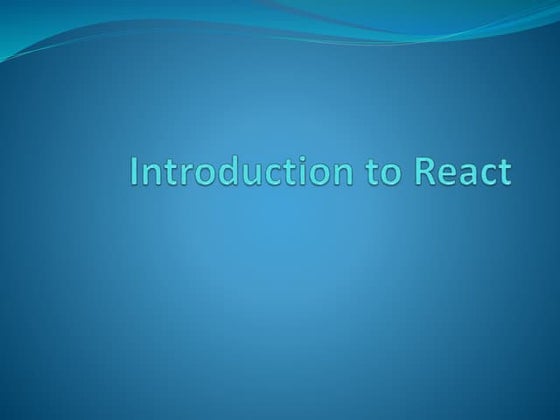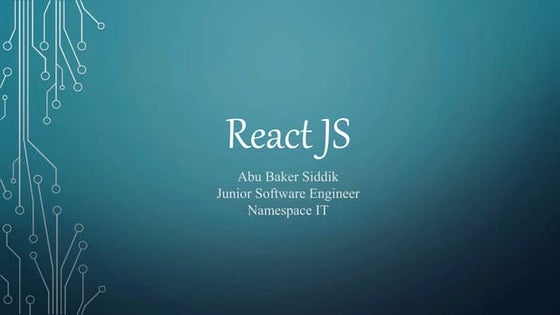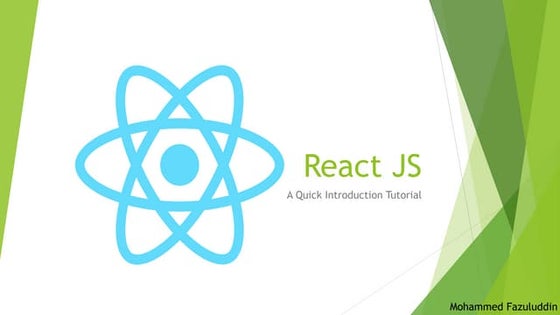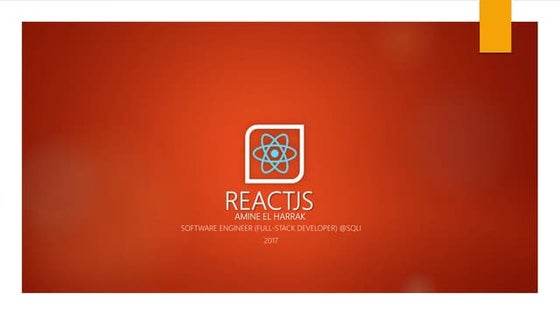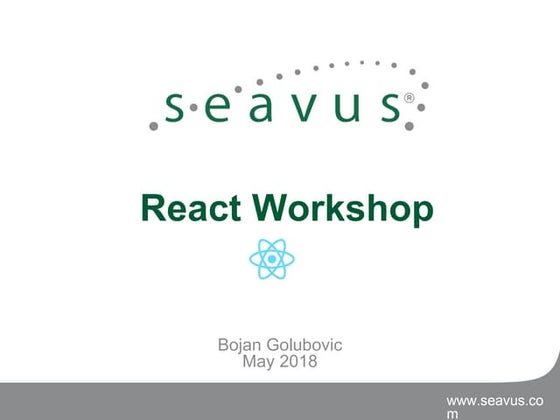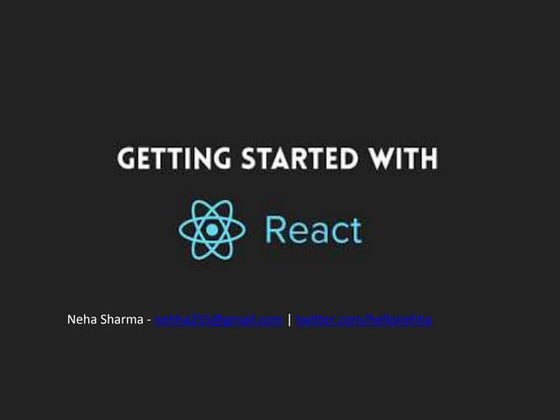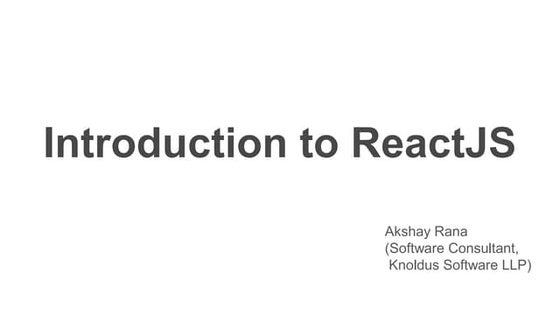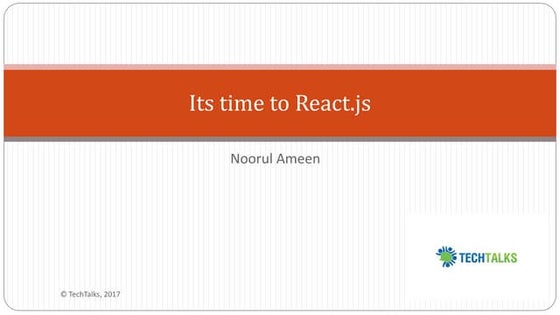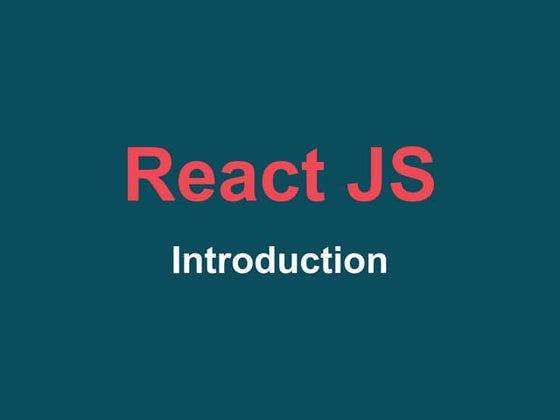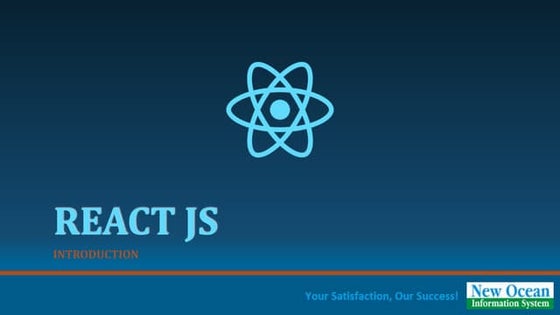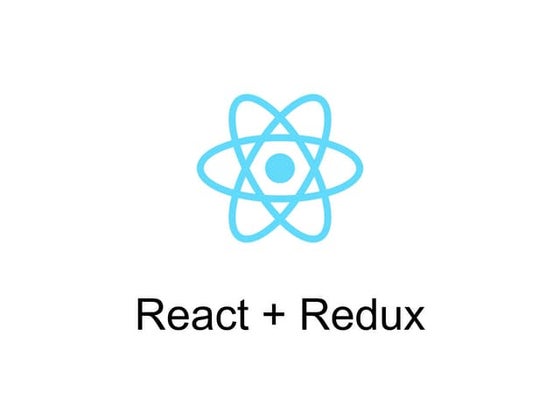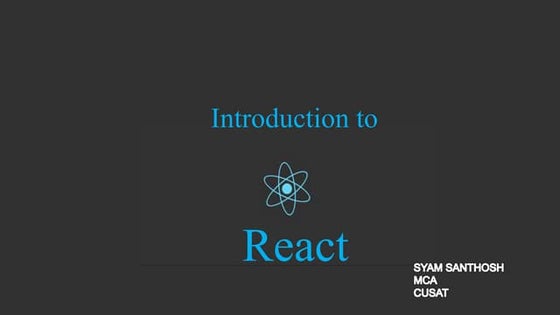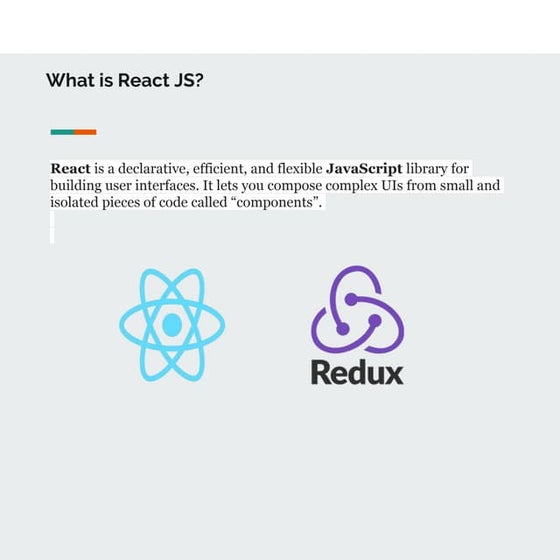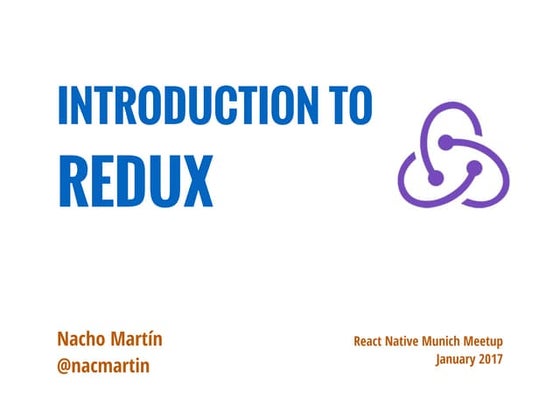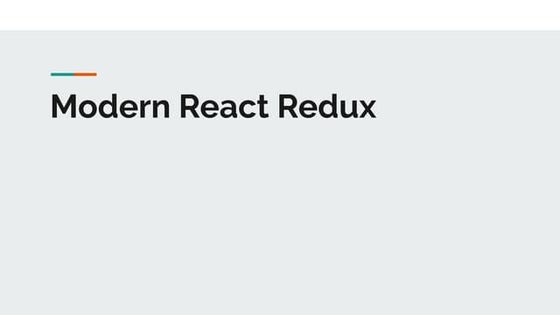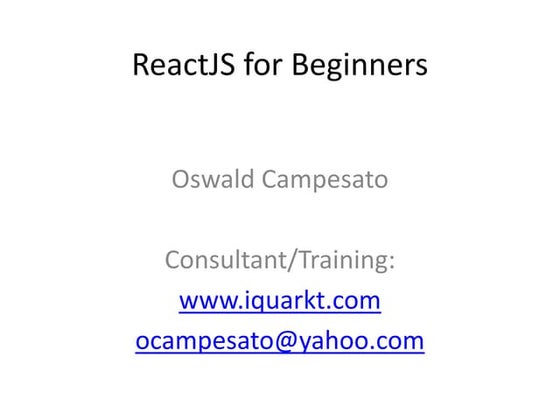[Final] ReactJS presentation
- 2. CONTENT ? Introduction React JS and JSX ? Component, State, Props. ? Life Cycle of Component ? Pros & Cos ? Demonstration
- 3. WHAT IS REACT? ? A JavaScript Library For Building User Interfaces ? Renders your UI and responds to events. ? It also uses the concept called Virtual DOM, creates an in-memory data structure cache, enumerates the resulting differences, and then updates the browserˇŻs displayed DOM efficiently. ? One of the unique features of React.js is not only it can perform on the client side, but it can also be rendered on the server side, and they can work together interoperably.
- 4. Angular has ? modules ? controllers ? directives ? scopes ? templating ? linking functions ? filters ? dependency injection WHAT IS REACT?
- 5. Angular has JUST COMPONENT ? modules ? controllers ? directives ? scopes ? templating ? linking functions ? filters ? dependency injection WHAT IS REACT?
- 6. #2 Single Source of Truth MVC proposes that your Model is the single source of truthˇŞ ?all state lives there. Views are derived from the Model, and must be kept in sync. When the Model changes, so does the View. WHAT IS REACT?
- 7. #2 Single Source of Truth MVC proposes that your Model is the single source of truthˇŞ ?all state lives there. Views are derived from the Model, and must be kept in sync. When the Model changes, so does the View. WHAT IS REACT? I AM DOUBLE-EDGED SWORD
- 8. #2 Single Source of Truth MVC proposes that your Model is the single source of truthˇŞ ?all state lives there. Views are derived from the Model, and must be kept in sync. When the Model changes, so does the View. WHAT IS REACT? I AM DOUBLE-EDGED SWORD Only render when state changed
- 9. WHAT IS REACT? ¨C VIRTUAL DOM ? Manipulate DOM is high cost. ? React first assembles the entire structure of your app in-memory, using those objects. Then, it converts that structure into actual DOM nodes and inserts them in your browserˇŻs DOM.
- 10. WHAT IS REACT? ¨C VIRTUAL DOM <script> var helloEl = React.createElement( 'div', { className: 'hello' }, 'Hello, world!ˇ® ); React.render(helloEl,document.body); </script>
- 11. JSX ? JSX = Javascript + XML. const element = <h1>Hello, world!</h1>;
- 12. JSX <script> var helloEl = React.createElement('div', { className: 'hello' }, 'Hello, world!'); React.render( helloEl, document.body ); </script> <script type="text/jsx"> var helloEl = <div className: "hello">Hello, world!</div>; React.render( helloEl, document.body ); </script>
- 13. JSX <script> var helloEl = React.createElement('div', { className: 'hello' }, 'Hello, world!'); React.render( helloEl, document.body ); </script> <script type="text/jsx"> var helloEl = <div className: "hello">Hello, world!</div>; React.render( helloEl, document.body ); </script>
- 14. COMPONENT ? Components let you split the UI into independent, reusable pieces, and think about each piece in isolation. ? Conceptually, components are like JavaScript functions. They accept arbitrary inputs (called "props") and return React elements describing what should appear on the screen.
- 17. COMPONENT class TodoInput extends React.Component { render() { return ( <div className="form-inline"> <input className="form-control" type="text" value={this.state.content} onChange={this.updateState}/> </div> ); } }
- 18. COMPONENT - PROPS ? Props is what you pass into the Component via attributes. ? Props is the only way to input data. (Or you can use Redux). ? Props are immutable. ? Container component will define data that can be changed ? Child Component will received data from parent component via props.
- 19. COMPONENT - PROPS import React from 'react'; class App extends React.Component { render() { return ( <div> <h1>{this.props.headerProp}</h1> <h2>{this.props.contentProp}</h2> </div> ); } } export default App; import React from 'react'; import ReactDOM from 'react-dom'; import App from './App.jsx'; ReactDOM.render( <App headerProp="Header from props..." contentProp="Content from props..."/>, document.getElementById('app') ); export default App;
- 20. COMPONENT - STATE ? Private data of component ? When change -> Re-render Component ? CanˇŻt read from outside Component
- 21. COMPONENT - STATE class TodoInput extends React.Component { constructor(props) { super(props); //Call this function because 'this' is not allowed before super(). this.state = { content: '' }; this.addTodo = this.addTodo.bind(this); } updateState(e) { this.setState({content: e.target.value}); } addTodo() { // We of course not declare onSave function of this component at parent component // Refer to: Body.jsx for more information // We declare this onSave at mapDispatchToProps function this.props.onSave.call(this, this.state.content, this.props.todo && this.props.todo.id || null); this.setState({ content: '' }) } render() { return ( <div className="form-inline"> <div className="form-group"> <input className="form-control" type="text" value={this.state.content} onChange={this.updateState}/> </div> </div> ); } } class TodoInput extends React.Component { constructor(props) { super(props); //Call this function because 'this' is not allowed before super(). this.state = { content: '' }; this.addTodo = this.addTodo.bind(this); } updateState(e) { this.setState({content: e.target.value}); } addTodo() { // We of course not declare onSave function of this component at parent component // Refer to: Body.jsx for more information // We declare this onSave at mapDispatchToProps function this.props.onSave.call(this, this.state.content, this.props.todo && this.props.todo.id || null); this.setState({ content: '' }) } render() { return ( <div className="form-inline"> <div className="form-group"> <input className="form-control" type="text" value={this.state.content} onChange={this.updateState}/> </div> </div> ); } }
- 22. REACT COMPONENT LIFECYCLE ? React enables to create components by invoking the React.createClass() method which expects a render method and triggers a lifecycle that can be hooked into via a number of so called lifecycle methods. ? This short article should shed light into all the applicable functions. ? Understanding the component lifecycle will enable you to perform certain actions when a component is created or destroyed. Further more it gives you the opportunity to decide if a component should be updated in the first place and to react to props or state changes accordingly.
- 23. THE LIFECYCLE - INITIALIZATION ? Occurs when the component is created. var Greeting = React.createClass({ propTypes: { name: React.PropTypes.string }, getDefaultProps: function () { return { name: 'Mary' }; }, getInitialState: function () { return { helloSentence: 'Hello' } } // ... });
- 24. THE LIFECYCLE - INITIALIZATION ? getDefaultProps and getInitialState not exists when define Component as Class ES6. Greeting.defaultProps = { name: 'Mary' }; constructor(props){ super(props); this.state = { name: 'Mary' } }
- 25. THE LIFECYCLE - INITIALIZATION ? Inside ComponentWillMount, setting state wonˇŻt trigger re-render whole component. ? We CAN NOT modify state in render method. ? DOM Manipulation is only permitted inside componentDidMount method.
- 26. THE LIFECYCLE - STATE CHANGES ? Occur when state is changed (via this.setState(..)) except inside componentWillMount methods shouldComponentUpdate: function(nextProps, nextState){ // return a boolean value return true; } ? shouldComponentUpdate returning false results in followed methods wonˇŻt be triggerd also. ? shouldComponentUpdate wonˇŻt triggered in the initial phase or when call forceUpdate(). ? Current State of Component DID NOT have new value,
- 27. THE LIFECYCLE - PROPS CHANGES ? Occurs when data passed from parent component to child component changed (via props). ? Changing states in ComponentWillReceiveProps DID NOT trigger re-render component. componentWillReceiveProps: function(nextProps) { this.setState({ // set something }); } Props Change ? componentWillReceiveProps trigged Props Change ? componentWillReceiveProps trigged NOT
- 28. THE LIFECYCLE - UNMOUNTING ? Used to clean up data
- 29. PROS & COS OF REACT.JS THE GOOD POINTS: ? React.js is extremely efficient - Virtual DOM ? It makes writing Javascript easier - React.js uses a special syntax called JSX ? It gives you out-of-the-box developer tools - React.js chrome extension ? ItˇŻs awesome for SEO - Server rendering ? UI Test Cases THE BAD: ? React.js is only a view layer. ? There is a learning curve for beginners who are new to web development. ? Library size. (~ Angular)
- 30. Why you should use React.js: ? React.js works great for teams, strongly enforcing UI and workflow patterns. ? The user interface code is readable and maintainable. ? Componentized UI is the future of web development, and you need to start doing it now. ? And also, there is now a lot of demand for developers with ReactJS experience.
- 31. Why you should NOT use React.js: ? Slow you down tremendously at the start. ? You will reinvent a lot of wheels.
- 32. ? Flux/Redux ? React Native OUR NEXT STEPS
- 33. REFERENCES ? https://firstdoit.com/how-i-learned-to-stop-worrying-and-love-react- 4e22b0bb6c2a#.vt2mjxu6s ? https://offroadcode.com/journal/news/reactjs-whats-it-all-about/ ? http://sixrevisions.com/javascript/why-i-ditched-angular-for-react/ ? https://github.com/hpphat92/my-todo-reactjs ? https://hpphat.wordpress.com/category/web-dev/react/ ? http://blog.andrewray.me/reactjs-for-stupid-people/ ? 192.168.1.240sharePhat.HongReactjs

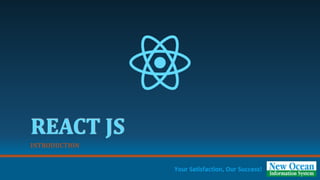


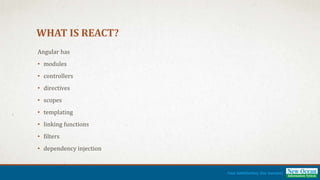
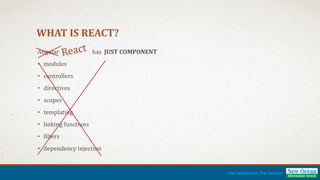
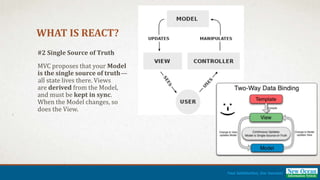
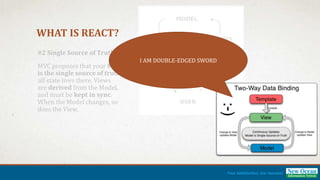

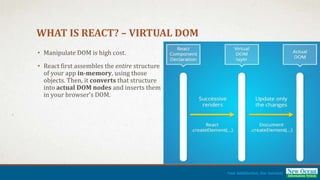
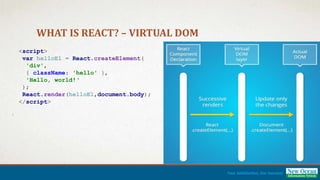
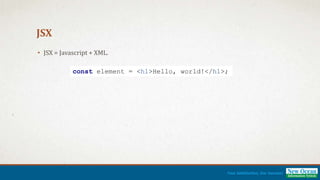
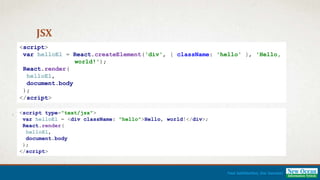

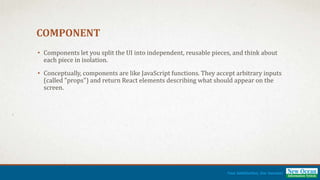
![[Final] ReactJS presentation](https://image.slidesharecdn.com/65cfd4f9-740f-4f41-b769-b496b6e60802-170119143904/85/Final-ReactJS-presentation-15-320.jpg)
![[Final] ReactJS presentation](https://image.slidesharecdn.com/65cfd4f9-740f-4f41-b769-b496b6e60802-170119143904/85/Final-ReactJS-presentation-16-320.jpg)
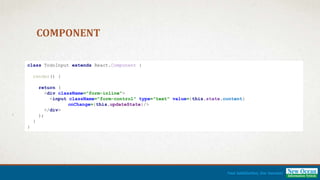

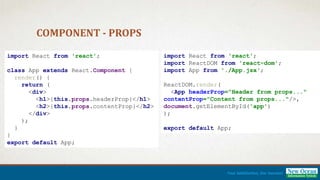
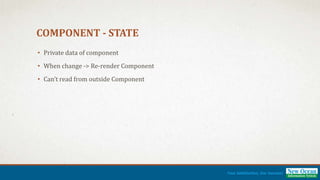



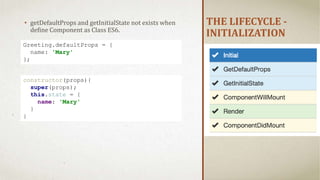
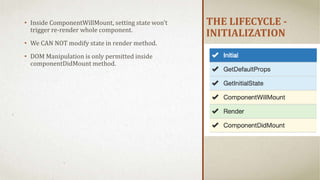

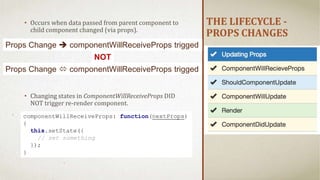
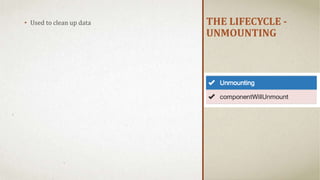
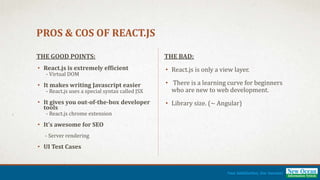
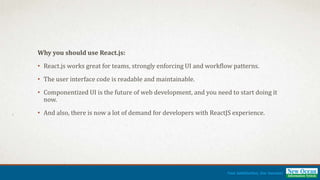
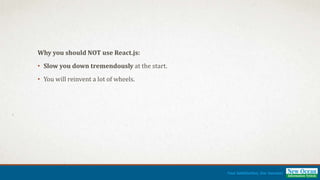

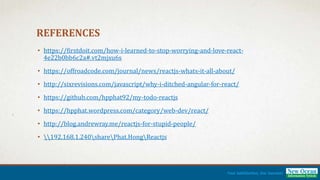
![[Final] ReactJS presentation](https://image.slidesharecdn.com/65cfd4f9-740f-4f41-b769-b496b6e60802-170119143904/85/Final-ReactJS-presentation-34-320.jpg)
![[Final] ReactJS presentation](https://image.slidesharecdn.com/65cfd4f9-740f-4f41-b769-b496b6e60802-170119143904/85/Final-ReactJS-presentation-35-320.jpg)
